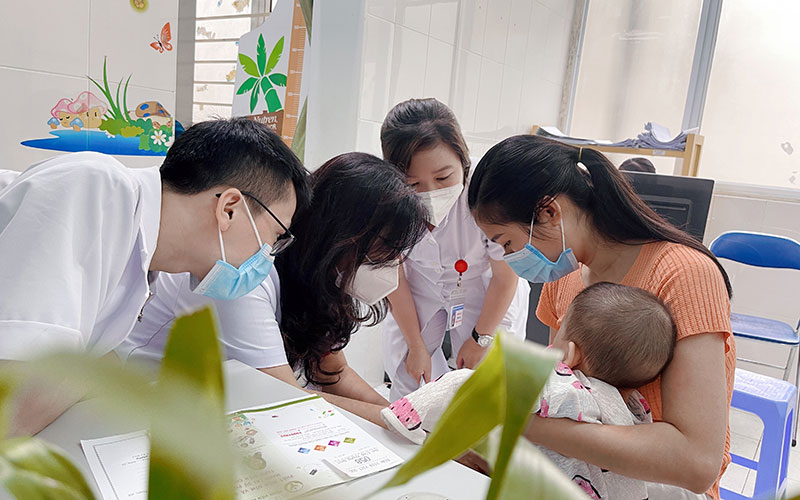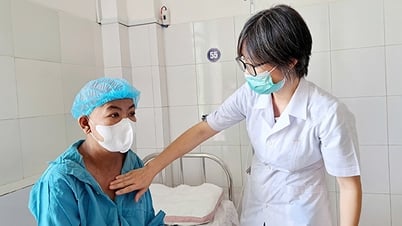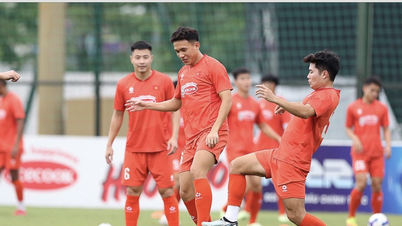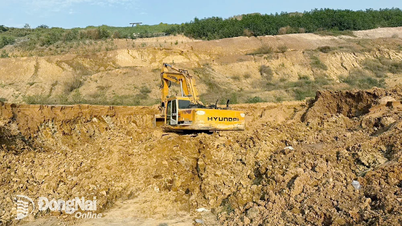Genital malformations are quite common in children, but many cases are not intervened early due to the view that "children will improve themselves when they grow up".
Mistaken gender of baby due to abnormal "that place"
After undergoing surgery for genital malformation for nearly 2 weeks, the boy NTD (2 years old, in Hanoi ) can now stand and urinate like other normal boys. The patient's mother said that since birth, the child was given a girl's name because he was fair and pretty. His physical development was also normal, but as he grew older, he showed more and more psychological and gender abnormalities. In particular, his private area was very unusual, not completely like a girl's, so the family took him to the hospital for examination.
Associate Professor, Dr. Nguyen Viet Hoa, Head of the Department of Pediatric and Neonatal Surgery at Viet Duc Hospital, said that during the examination, the doctor discovered that the baby had a low urethral opening, and the perineum was split in two, causing the penis to be buried between the two sides of the scrotum, making it look like a clitoris. The baby also had two testicles that had not descended into the scrotum, located in the inguinal canal. When further gender determination tests were performed, including chromosome genetic testing, testicular differentiation genes, and endocrine tests, they all confirmed that the baby was male.

Associate Professor, Dr. Nguyen Viet Hoa examines children with genital malformations
The patient underwent surgery to lower both testicles into the scrotum and most recently, urethroplasty to move the low urethral opening from the perineum to the tip of the glans. "After 10 days, the catheter was removed and the child was able to urinate standing up like other normal boys. The patient's family has prepared the procedures to change the child's name and gender on the birth certificate," said Associate Professor, Dr. Hoa.
Previously, another patient, a boy named HGV (3 years old, in Hai Duong ), was brought to the hospital by his parents because the examination showed that he did not have a left testicle. The ultrasound results showed that the left testicle was located in the groin and surgery was indicated to lower the testicle into the scrotum.
Associate Professor, Dr. Hoa said that baby V. is one of many children whose birth defects were detected and treated promptly. However, during the examination, doctors encountered many cases where children came for intervention very late even though the family had previously discovered the problem because of the belief that "children will improve themselves when they grow up".
According to Associate Professor, Dr. Hoa, it is not uncommon for a patient to come to the clinic as a girl on paper, but when the family sees that they have reached puberty, their child has no breasts, no menstruation... "A typical example is a male patient with a congenital defect of low perineal urethral opening and bilateral cryptorchidism. When he was born, because his "bird" was very small, his penis was bent down, and his testicles were not visible (because of cryptorchidism), the family automatically considered him a girl. For more than ten years, this person developed in a girl's mentality, with long hair" - Associate Professor, Dr. Hoa said.
Don't let your son grow up still "sitting to pee"
According to Associate Professor, Dr. Hoa, research shows that congenital genital malformations are at the top of congenital malformations in children. At the Department of Pediatric and Neonatal Surgery at Viet Duc Hospital, about 2/3 of surgical cases are congenital genital malformations... The cause of congenital genital malformations in children has not been determined, but there are a number of related factors such as: the mother having flu during pregnancy, consanguineous marriage... For boys, genital malformations are often low or high deviation of the urethra, hidden testicles, congenital peritoneal canal (inguinal hernia, spermatic cord cyst, hydrocele), penile collapse. For girls, common abnormalities are hernia of the labia majora, ovarian tumors, vulvar adhesions, common urogenital sinus...
Dr. Le Anh Dung, Head of the Department of Urology at the National Children's Hospital, said that hypospadias is an anatomical abnormality of the genitals in boys, including a curved penis and a urethral opening located lower than normal. The incidence of this disease is 1/300 male children, mainly due to abnormalities during fetal formation.
According to Dr. Dung, hypospadias can be easily observed immediately after birth. The typical symptom is that the child's urethra is not located at the tip of the penis but along the underside of the penis shaft, so the urine stream is not straight forward but is deflected downward or backward. If the urethra is too close to the base of the penis, the child cannot stand to urinate but must sit down to urinate. In addition, there are some cases of narrow urethra, small urine stream, and the child's urination time will be prolonged. When a child has a curved penis and does not intervene, when they reach adulthood, sexual activity will be difficult.
Experts recommend that "correcting" gender abnormalities should be done as soon as possible. Because when children realize they may feel inferior and self-conscious because of their differences, they are easily teased by friends, are afraid to communicate, afraid to go to the toilet... If they wait until adulthood to correct or re-determine their gender, it will greatly affect their life, work and fertility.
Genital malformations need intervention before 2 years old
Associate Professor, Dr. Nguyen Viet Hoa said that congenital genital malformations are usually not acute diseases, so many cases are detected late. Many families even think that they should wait until the child is older to treat the disease. Meanwhile, with cryptorchidism, doctors recommend that it should be detected immediately after birth to have a plan to monitor and treat the child early.
"Children need intervention before the age of 2 so that their future fertility is not affected. The longer the delay, the greater the risk of losing reproductive and sexual functions and the possibility of the patient developing testicular cancer due to being in the wrong position for too long. In addition, other complications can occur due to cryptorchidism such as testicular torsion, traumatic rupture of the cryptorchidism..." - Associate Professor, Dr. Hoa noted.
Source



























![[Photo] President Luong Cuong works with Hung Yen and Thai Binh Provincial Party Committees on implementing Resolution of the 11th Central Conference, 13th tenure](https://vphoto.vietnam.vn/thumb/1200x675/vietnam/resource/IMAGE/2025/6/6/127b735d2761484d81dcee0d7725a25b)

![[Photo] General Secretary To Lam receives Korean Ambassador to Vietnam](https://vphoto.vietnam.vn/thumb/1200x675/vietnam/resource/IMAGE/2025/6/6/a0765b7543784cbcbfe4755b67d43ab4)


























































![[OCOP REVIEW] Tu Duyen Syrup - The essence of herbs from the mountains and forests of Nhu Thanh](https://vphoto.vietnam.vn/thumb/402x226/vietnam/resource/IMAGE/2025/6/5/58ca32fce4ec44039e444fbfae7e75ec)











Comment (0)